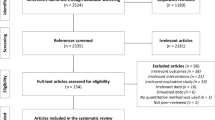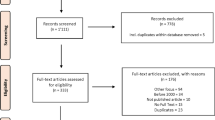Abstract
Choosing outcome measures for HIV prevention intervention studies is difficult because of the multiplicity of behavioral and epidemiologic factors that affect HIV transmission. In attempts to address some of these factors, summary risk indices have been proposed as outcome measures for some intervention studies. These summary risk indices have suffered from a number of methodological difficulties (e.g., some indices are not expressed in meaningful units). We present six criteria that can be used to judge the soundness of summary risk indices. Further, we illustrate that the central equation from a (Bernoullian) mathematical model of HIV transmission can be used as a summary risk index, and that it meets these six criteria.
Similar content being viewed by others
REFERENCES
Aral, S., and Peterman, T. A. (1996). Measuring outcomes of behavioral interventions for STD/HIV prevention. International Journal of STD and AIDS, 7(Suppl. 2), 30–38.
Blower, S. M., and Boe, C. (1993). Sex acts, sex partners, and sex budgets: Implications for risk factor analysis and estimation of HIV transmission probabilities. Journal of Acquired Immune Deficiency Syndromes, 6, 1347–1352.
Blower, S. M., Hartel, D., Dowlatabadi, H., Anderson, R. M., and May, R. M. (1991). Drugs, sex and HIV: A mathematical model for New York City. Philosophical Transactions of the Royal Society of London (B), 321, 171–187.
Blower, S. M., van Griensven, G. J. P., and Kaplan, E. H. (1995). An analysis of the process of human immunodeficiency virus sexual risk behavior change. Epidemiology, 6, 238–242.
Brookmeyer, R., and Gail, M. H. (1994). AIDS epidemiology: A quantitative approach. New York: Oxford University Press.
Downs, A. M., and DeVincenzi, I. (1996). Probability of heterosexual transmission of HIV: Relationship to the number of unprotected sexual contacts. Journal of Acquired Immune Deficiency Syndromes and Human Retrovirology, 11, 388–395.
Fineberg, H. V. (1988). Education to prevent AIDS: Prospects and obstacles. Science, 239, 592–596.
Garnett, G. P., and Anderson, R. M. (1995). Strategies for limiting the spread of HIV in developing countries: Conclusions based on studies of the transmission dynamics of the virus. Journal of Acquired Immune Deficiency Syndromes and Human Retrovirology, 9, 500–513.
Gibson, D., and Young, M. (1994). Importance of appropriate outcome measures in HIV behavioral research. Journal of Acquired Immune Deficiency Syndromes, 7, 631–632 (letter).
Hearst, N., and Hulley, S. B. (1988). Preventing the heterosexual spread of AIDS. Journal of the American Medical Association, 259, 2428–2432.
Holmberg, S. (1996). The estimated prevalence and incidence of HIV in 96 large U. S. metropolitan areas. American Journal of Public Health, 86, 642–654.
Holtgrave, D. R., and Kelly, J. A. (1996). The cost-effectiveness of an HIV/AIDS prevention intervention for at-risk women attending urban primary care clinics. American Journal of Public Health, 86, 1442–1445.
Jacquez, J. A., Koopman, J. S., Simon, C. P., and Longini, I. M. (1994). Role of the primary infection in epidemics of HIV infection in gay cohorts. Journal of Acquired Immune Deficiency Syndromes, 7, 1169–1184.
Kahn, J. G., Washington, A. E., Showstack, J. A., Berlin, M., and Phillips, K. (1992). Counseling and testing. In Updated estimates of the impact and cost of HIV prevention in injection drug users (pp. 47–66). San Francisco: University of California, San Francisco, Institute for Health Policy Studies.
Kaplan, E. H. (1990). Modeling HIV infectivity: Must sex acts be counted? Journal of Acquired Immune Deficiency Syndromes, 3, 55–61.
Kaplan, E. H., and Brandeau, M. L. (1994). Modeling the AIDS epidemic: Planning, policy and prediction. New York: Raven Press. ei]Miller, H. G., Turner, C. F., and Moses, L. E. (Eds.), (1990). AIDS: The second decade (pp. 359–472). Washington, DC: National Academy Press.
Moses, S., Plummer, F. A., Ngugi, E. N., Nagelkerke, N. J. D., Anzala, A. O., and Ndinya-Achola, J. O. (1991). Controlling HIV in Africa: Effectiveness and cost of an intervention in a high-frequency STD transmitter core group. AIDS, 5, 407–411. ia]National Institute on Drug Abuse. (1994). Outreach/risk reduction strategies for changing HIV-related risk behaviors among injection drug users (pp. 33–34). Rockville, MD: U.S. Department of Health and Human Services.
Ostrow, D. G., VanRaden, M. J., Fox, R., Kingsley, L. A., Dudley, J., and Kaslow, R. A. (1990). Recreational drug use and sexual behavior change in a cohort of homosexual men. AIDS, 4, 759–765.
Pinkerton, S. D., and Abramson, P. R. (1993). Evaluating the risks: A Bernoulli process model of HIV infection and risk reduction. Evaluation Review, 17, 504–528.
Pinkerton, S. D., and Abramson, P. R. (1994). An alternative model of the reproductive rate of HIV infection: Formulation, evaluation, and implications for risk reduction interventions. Evaluation Review, 18, 371–388.
Pinkerton, S. D. and Abramson, P. R. (1996). Implications of increased infectivity in early-stage HIV infection: Application of a Bernoulli-process model of HIV transmission. Evaluation Review, 20, 516–540.
Pinkerton, S. D., and Abramson, P. R. (1997). Effectiveness of condoms in preventing HIV transmission. Social Science and Medicine, 44, 1303–1312.
Pinkerton, S. D., and Abramson, P. R. (under review). The Bernoulli-process model of HIV transmission: Applications and implications. In, D. R. Holtgrave (Ed.), Handbook of AIDS policy studies. New York: Plenum Press.
Pinkerton, S. D., Holtgrave, D. R., and Valdiserri, R. O. (1997). Cost-effectiveness of HIV prevention skills training for men who have sex with men. AIDS, 11, 347–357
Reiss, I. L. and Leik, R. K. (1989). Evaluating strategies to avoid AIDS: Number of partners vs. use of condoms. Journal of Sex Research, 26, 411–433.
Service, S. K., and Blower, S. M. (1995). HIV transmission in sexual networks: An empirical analysis. Proceedings of the Royal Society of London (B), 260, 237–244.
Stall, R., McKusick, L., Wiley, J., Coates, T. J., and Ostrow, D. G. (1986). Alcohol and drug use during sexual activity and compliance with safe sex guidelines for AIDS: The AIDS behavioral research project. Health Education Quarterly, 13, 359–371.
Weinstein, M. C., Graham, J. D., Siegel, J. E., and Fineberg, H. V. (1989). Cost-effectiveness of AIDS prevention programs: Concepts, complications and illustrations. In C. F. Turner, H. G. Miller, and L. E. Moses (Eds.), AIDS: Sexual behavior and intravenous drug use (pp. 471–499) Washington, DC: National Academy Press.
Wittkowski, K. M. (1989). Preventing the heterosexual spread of AIDS: What is the best advice if compliance is taken into account? AIDS, 3, 143–145.
Author information
Authors and Affiliations
Rights and permissions
About this article
Cite this article
Holtgrave, D.R., Leviton, L.C., Wagstaff, D.A. et al. Cumulative Probability of HIV Infection: A Summary Risk Measure for HIV Prevention Intervention Studies. AIDS Behav 1, 169–172 (1997). https://doi.org/10.1023/B:AIBE.0000002977.08417.5e
Issue Date:
DOI: https://doi.org/10.1023/B:AIBE.0000002977.08417.5e




